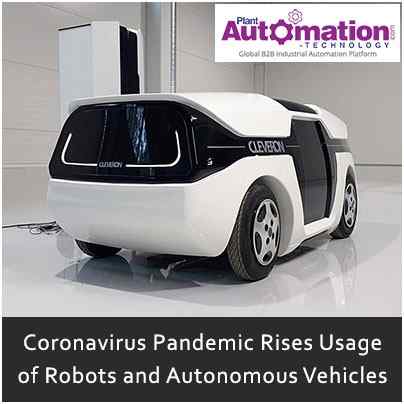Coronavirus Pandemic Rises Usage of Robots and Autonomous Vehicles

The coronavirus COVID-19 pandemic is the greatest challenge we’ve faced since World War Two. The pandemic is moving sort of a wave – one that may yet crash on those least ready to cope. Since the coronavirus took hold, there has been a significant increase in orders for mobile robots and automated guided vehicles. Before the pandemic, human work has been replaced in a variety of jobs, from all centers to warehouses and grocery stores, as companies looked to chop labor costs and improve profitability. Due to the rapid technological advances in robotics and automation, the manufacturing sector has seen an increase in the incorporation of mobile robots and technology into its production process. This and similar developments once more bring into focus the motivation, and sometimes the imperative, to extend automation within the logistics and delivery chain. Automation within the delivery/logistics and warehousing/fulfillment chain is a rising market. A particularly exciting subset of this is often the utilization of mobile robots, drones, and automation vehicles, for automation of movement-based tasks. This field includes all manner of robots, drones, and autonomous vehicles, which help goods in their journey from origin to destination. In recent years, the automated market for guided vehicles has seen growth with rising interest and a move toward automated systems and innovations. The global automated guided vehicles market is set to exhibit a stupendous $81 and $290 billion in 2030 and 2040 respectively.
The automated guided vehicles and carts (AGV and AGC) have been in use for a long time. They deliver a range of benefits, such as a reduction in operating costs, a decrease in production time, and increased safety of the workforce. Besides, the growing implementation of mobile robots worldwide and initiatives to improve safety and productivity at work are the other factors leading to the adoption of automated guided vehicles. They are consistent and trusted to handle all manner of payloads. However, their installation is time-consuming, and their workflow is difficult to adapt. To help automate the goods-to-person, large fleets of robots are already deployed in many fulfillment centers. Special robot-only zones are created within the warehouses wherein these robots move racks at high speeds to manned picking stations.
The use of autonomous mobile robots and vehicles is another major trend. The autonomous mobile robots are emerging, which present infrastructure-independent navigation in defined indoor environments. This allows the workflow to be easily modified and enable various modes of collaborative workflows between robots and humans. These robots enhance productivity and enable several hybrid human-robot interaction modes. They can also bring automation to warehouses and fulfillment centers which were not specifically designed and built to support robotic goods-to-person. The navigation technology is hence transitioning from automated to autonomous. The technology is enabled by better SLAM algorithms. The algorithms supporting various sensors, including 2D lidars and stereo cameras are evolved enough to handle safe autonomous navigation within many structured indoor environments. These robots are easy to put in and to train. However, the technology options are still many, and choices have long-lasting strategic consequences. The business models are also several and evolving. Few are offering their technology as RaaS (robot as a service), while others are following a traditional model of equipment sales. These suppliers will also need to build in a subscription platform into their business model to provide maintenance and upgrades, particularly cloud-based software updates.
An essential component of warehousing automation is picking or grasping technology. Many firms and research groups today are deploying deep learning to enable robots to pick a novel and irregularly shaped items swiftly and with high success rates. A restricted number of firms have integrated picking arms on mobile platforms. These days, they mainly pick box-shaped items in known environments. However, technological progress will bring these technologies to more diverse items. It will also allow better incorporation of the robotic arm with the mobile platform. Autonomous forklifts and tugs that are manually operated are emerging onto the market. However, the rise of autonomous mobility technology will change the trend. Indeed, the journey has already been begun long back. Many have demonstrated, developed, and demonstrated autonomous forklifts and trucks. The choice of navigation technology has progressed significantly. The cost of these autonomous forklifts is naturally higher, but the claimed ROI by many suppliers is within 12-18 months. Apart from the cost of the autonomous sensor suite, traction control, and drivers, and therefore the software, which may be amortized over a growing deployed fleet, the cost also includes the installation and maintenance cost. Overall, price parity on an annual operational cost basis is almost at hand in some high wage territories.
The most expensive part of the delivery chain, often representing more than 50% of the overall cost is the last-mile delivery. This is an interesting technological frontier. Many companies in recent years have been innovating to utilize autonomous mobile robots, autonomous vehicle technology, drones to automate this step. As such, there’s a strong commercial incentive to automate this step to increase productivity. There are two approaches – one is the on-road last-mile delivery vans or pods and side-walk robotic. Many technological challenges are shared by the on-road vans and pods with other on-road autonomous vehicles. However, the difference is that they can operate in limited well-mapped, and known-environments and that they can potentially travel at low-speeds. They will also not have passengers on-board, simplifying some of the safety challenges. The side-walk robots have their unique design and technology challenges and are often designed to travel slowly at 4-6 km/hr. This is to increase safety, to give robots more thinking time, to give remote teleoperators the chance to intervene, and to enable sorting the robot as a personal device, thus easing the legislative challenges. These robots also come with several hardware choices. These sidewalk robots are still far from being autonomous. First, they are often deployed in environments where there’s little sidewalk traffic and where the sidewalks are well-structured. Several robots are also restricted to perception-free conditions and also daylight. The suppliers also have remote teleoperator centers. If such businesses are to succeed, the ratio of operators to robots will need to be kept to an absolute minimum.
There’s still much work to do to improve the navigation technology. The robots will need to learn to operate in more varied and complex environments with minimal intervention. Furthermore, capital is also crucial. The end markets are also highly competitive, imposing harsh price constraints.










